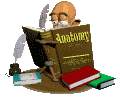|
|
Chapter
4:Skin and Membranes
Anatomy
& Physiology
Marymount High School
a
journey into the inner workings of the human body!
|
|
|
Teacher:
Judith S. de Nuño
jdenuno@mhs-la.org
|
WebSites
http://members.home.net/jdenuno
Science
at Marymount
|
Office
Hours
Daily
at Lunch in the
Science
Patio
|
Cyber
Office Hours
AIM:
teachsci23

|
|
|
|
|
|
|
|
Highlight
the section(s) you want to copy, copy, and paste into your word processor.
Fill in with details and notes from text. Make flash cards! Keep in anatomy
notebook.
|
|
Chapter
4 Objectives
- Classification
of Body Membranes (pp. 92-94)
- List
the general functions of each membrane type - cutaneous,
mucous, serous, and synovial - and give its location in
the body.
- Compare
the structure (tissue makeup) of the major membrane types.
- Integumentary
System (Skin) (pp. 94-105)
- List
several important functions of the integumentary system
and explain how these functions are accomplished.
- When
provided with a model or diagram of the skin, recognize
and name the following skin structures:epidermis, dermis
(papillary and reticular layers), hair and hair follicle,
sebaceous gland, and sweat gland.
- Name
the layers of the epidermis and describe the characteristics
of each.
-
Describe the distribution and function of the epidermal
derivatives - sebaceous glands, sweat glands, and hair.
- Name
the factors that determine skin color and describe the function
of melanin.
- Differentiate
between first-, second-, and third-degree burns.
- Explain
the importance of the "rule of nines."
- Summarize
the characteristics of basal cell carcinoma, squamous cell
carcinoma, and malignant melanoma.
- Developmental
Aspects of Skin and Body Membranes (pp. 105-107)
- List
several examples of integumentary system aging.
|
|
Chapter
4 Outline Framework
- CLASSIFICATION
OF BODY MEMBRANES (pp. 92-94)
- Epithelial
Membranes (pp. 92-94)
- Cutaneous
Membrane
- Mucous
Membranes
- Serous
Membranes
- Connective
Tissue Membranes (p. 94)
- INTEGUMENTARY
SYSTEM (SKIN) (pp. 94-105)
-
Basic Skin Functions (pp. 94-95)
- Structure
of the Skin (pp. 95-98)
- Epidermis
- Stratum
Basale
- Stratum
Spinosum
- Stratum
Granulosum
- Stratum
Lucidum
- Stratum
Corneum
- Dermis
- Papillary
Layer
- Reticular
Layer
- Skin
Color (pp. 98-99)
- Appendages
of the Skin (pp. 99-101)
- Cutaneous
Glands
- Sebaceous
(Oil) Glands
- Sweat
Glands
- Eccrine
Glands
- Apocrine
Glands
- Hairs
and Hair Follicles
- Nails
- Homeostatic
Imbalances of the Skin (pp. 101-105)
- Infections
and Allergies
- Athlete's
Foot
- Boils
and Carbuncles
- Cold
Sores
- Contact
Dermatitis
- Impetigo
- Psoriasis
- Burns
- First-degree
- Second-degree
- Third-degree
- Skin
Cancer
- Basal
Cell Carcinoma
- Squamous
Cell Carcinoma
- Malignant
Melanoma
- DEVELOPMENTAL
ASPECTS OF SKIN AND BODY MEMBRANES (pp. 105-107)
back
to top
|
|
Chapter
Terms: Skin
and Membranes pp. 92~107
- epithelial
membranes
- cutaneous
membranes
- mucous
membranes (mucosa, mucosae)
- serous
membranes (serosa, serosae)
- serous
fluid
- peritoneum
- pleura
- pericardium
- synovial
membranes
- Integumentary
System (Skin)
-
integument
- epidermis
- keratinizing
dermis
- subcutaneous
tissue (hypodermis)
- keratinocytes
- stratum
basale
- stratum
germinativum
- stratum
spinosum
- stratum
granuolsum
- stratum
lucidum
- stratum
corneum
- melanin
- melanocytes
- dermis
- papillary
layer
- dermal
papillae
- reticular
layer
- skin
color
- erythema
pallor (blanching)
- jaundice
- skin
appendates
- cutaneous
glands
- exocrine
glands
- sebaceous
(oil) glands
- sebum
- sweat
glands (sudoriferous glands)
- eccrine
sweat glands
- sweat
- pore
- apocirne
sweat glands
- hair
- hair
follicle
- root
- shaft
- hair
bulb
- matrix
- arrector
pili
- nails
- skin
problems
- athlete's
foot
- boils
and carbuncles
- cold
sores (fever blisters)
- contact
dermatitis
- impetigo
- psoriasis
- burns
- rule
of nines
- first-degree
burns
- second-degree
burns
- partial-thickness
burns
- third-degree
burns
- full-thickness
burns
- skin
cancer
- basal
cell carcinoma
- squamous
cell carcinoma
- malignant
melanoma
- ABCD
Rule (assymetry, border irregularity, color, diameter)
back
to top
|
|
|
Chapter
4 WebLinks
|
|
|
|
|
|
|
|
|
|
|
back
to top
|
|
|
|
|
|
|
|
|
|
|
|
|
|
|
|
|
|
|
|
|
- The
Virtual Hospital
- http://www.vh.org/
- The Virtual Hospital is a digital
health sciences library created in 1992 at the University of Iowa
to help meet the information needs of health care providers and
patients. The goal of the Virtual Hospital digital library is
to make the Internet a useful medical reference and health promotion
tool for health care providers and patients.
- The Virtual Hospital contains over
350 peer-reviewed books and booklets from 160 authors in 29 departments
and 4 colleges on The University of Iowa campus.
|
|
|
|
|
|

Some
Useful Search Sites
|
|
|
|
|
|
|
|
![]()








